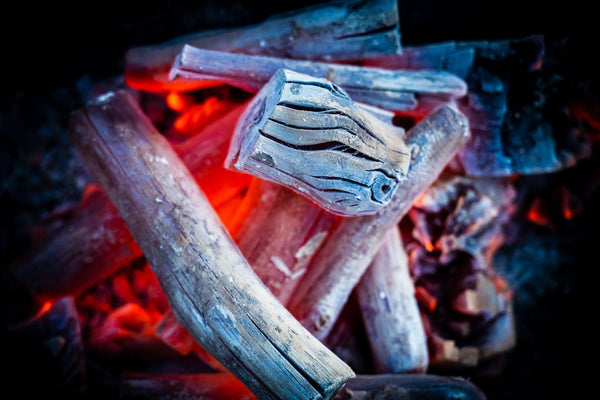
Jump to:
Have you savored the perfectly grilled, smoky-sweet flavor of yakitori (grilled chicken) at a Japanese restaurant before?
If so, you've likely experienced the magic of binchotan charcoal.
This isn't your average backyard barbecue stuff – binchotan is often called the "black diamond" of charcoal, and for good reason. Its ability to burn at high temperatures with almost no smoke has made it a big hitter in Japanese cuisine, particularly in grilling.
But what exactly is this mysterious charcoal, and why is it so revered?
For culinary enthusiasts and those curious about Japanese cooking techniques, this guide will introduce you to binchotan. We'll explore its history, how it's made, why it's considered superior to other charcoals and how you can use it to bring a taste of Japan to your own kitchen.
Time to fire up the grill! Let’s get cooking on the story of binchotan charcoal.
What Is Binchotan Charcoal?

Binchotan charcoal, also known as white charcoal or Japanese oak charcoal, is a type of activated charcoal that's been a staple in Japanese cooking for centuries.
The name Binchotan comes from a combination of "bincho," referring to the region where it was first produced, and "tan," meaning charcoal.
Unlike the typical lump or briquette charcoal you might be familiar with, binchotan is dense, hard and nearly pure carbon. It's made from oak, specifically the ubame oak tree native to the Kii Peninsula in Wakayama Prefecture, Japan. This particular oak species, known for its density and slow growth, is crucial to creating the unique properties of binchotan.
What Sets Binchotan Apart from Other Charcoal?
What sets binchotan apart is its production process, which involves extremely high temperatures and rapid cooling. This results in a charcoal that's incredibly pure, with a carbon content of up to 95%.
When you hold a piece of binchotan, you'll notice it's heavier than you might expect, and it makes a clear, almost metallic sound when tapped – both signs of its high density and purity.
Visually, binchotan is quite striking. It's often a silvery-gray color with a slightly shiny surface, earning it the nickname "white charcoal" despite its dark appearance. The surface of binchotan is smooth and hard, without the flaky or crumbly texture you might associate with other types of charcoal.
But binchotan isn't just about looks. The real magic lies in how it burns.
Burn Hot: The Binchotan Charcoal Story
When lit, binchotan reaches extremely high temperatures – up to 1,000°C (1,832°F) – yet produces almost no smoke or odor.
Binchotan burns steadily and evenly for hours, radiating a powerful heat that's ideal for grilling. This combination of high heat and minimal smoke allows the true flavors of the food to shine through.
It’s understandable, isn’t it, that binchotan charcoal is prized by chefs for grilling delicate items like yakitori (grilled chicken skewers) and other meats and vegetables.
Other Uses & Applications for Binchotan
While primarily known for its culinary uses, binchotan's unique properties have led to its application in various other fields.
From water purification to skincare products (like the Orim Binchotan Charcoal Body Scrub Towel Exfoliating Washcloth), this versatile charcoal has found its way into many aspects of daily life.
In the following sections, we'll explore more about how binchotan is made, why it's considered superior to other charcoals and how you can use it to elevate your own cooking.
How Is Binchotan Charcoal Made?

The production of binchotan is an art form that has been perfected over centuries.
The process begins with carefully selected ubame oak, which is cut into manageable pieces and placed in a specially designed kiln.
The kiln is heated to extremely high temperatures, around 1000°C (1832°F), for several days. This intense heat drives out all impurities and moisture from the wood.
The crucial step comes next: rapid cooling. The charcoal is removed from the kiln and quickly smothered with a mixture of sand, ash and earth. This sudden cooling is what gives binchotan its characteristic hardness and metallic sound. The result is a charcoal that's incredibly dense and pure.
What Is Binchotan Charcoal Used For In Japan?

While binchotan has various applications, its primary use is in cooking, particularly grilling.
Binchotan is the fuel of choice for yakitori restaurants, where chefs use it to grill skewered chicken and vegetables to perfection. The high, steady heat and lack of smoke allow the natural flavors of the food to shine through.
Having been to a variety of yakitori restaurants in Japan, it’s apparent pretty quickly who’s using binchotan charcoal for their grilling and who isn’t. It’s something you can smell when walking through the doors of the establishment. And binchotan is definitely something you can taste; likewise, if they’re not cooking with binchotan, the taste (while passable or even good) is just never quite the same.
Binchotan charcoal brings your grilled chicken and vegetable game to whole new levels.
Beyond cooking, binchotan is used for water purification, as a deodorizer, and in beauty products. Some people even use it in the bath, believing it can help improve circulation and detoxify the body.
Why Is Binchotan Superior?
Several factors contribute to binchotan's superiority:
- High heat: It burns at higher temperatures than regular charcoal, allowing for more efficient cooking.
- Long-burning: A single piece can burn for several hours, making it economical.
- Low smoke: It produces minimal smoke, preserving the natural flavors of the food.
- No odor: Unlike some charcoals, binchotan doesn't impart any unwanted flavors to the food.
- Reusable: With proper care, binchotan can be reused multiple times.
Why Is Binchotan So Popular In Japan?
Binchotan's popularity in Japan stems from an alignment with Japanese culinary philosophy.
Japanese cuisine often emphasizes the natural flavors of ingredients, and binchotan's clean-burning properties allow these flavors to shine.
Its long history and the craftsmanship involved in its production also appeal to the Japanese appreciation for tradition and artisanal products.
How To Use Binchotan Charcoal

Using binchotan requires some patience and technique:
- Start early: Binchotan takes longer to light than regular charcoal, so start about 30-45 minutes before you want to cook.
- Use a chimney starter or a specialized binchotan starter.
- Once lit, spread the coals evenly in your grill.
- Allow the coals to burn until they're glowing red and covered with a white ash.
- Start grilling! Remember, binchotan provides intense, direct heat, so keep a close eye on your food.
What Kind of Grills Can You Use with Binchotan?
Binchotan works best with grills designed for its use, such as:
- Konro grills: These small, rectangular grills are perfect for yakitori and other skewered foods.
- Hibachi grills: These classic Japanese grills are ideal for binchotan.
- Shichirin: A small, portable grill often made of diatomaceous earth; such as this charcoal grill or this one (both are from industry leader Ikenaga Iron Works)
While you can use binchotan in Western-style grills, it's most effective in these traditional Japanese designs.
Different Types Of Binchotan

While true binchotan comes from ubame oak, there are other varieties:
- Kishu Binchotan: The highest grade, from Wakayama Prefecture.
- Tosa Binchotan: From Kochi Prefecture, slightly softer but still high-quality.
- Nagata Binchotan: A more affordable option, still made from hardwood but not ubame oak.
While the process of lighting binchotan charcoal may seem a bit longer, it pays off in superior technique and fantastic flavor results!
Can You Reuse Binchotan?
Yes!
One of the great advantages of binchotan is that it can be reused multiple times.
After your grilling session, carefully remove any ash and store the used charcoal in a dry place. The next time you grill, mix these pieces with fresh binchotan.
How to Reuse and Store Binchotan
To reuse binchotan:
- After grilling, let the charcoal cool completely
- Submerge the cooled charcoal in water for about 10 minutes
- Remove and let dry thoroughly
- Store in a dry place until your next grilling session
That’s why binchotan is an investment in quality that will pay off over time.
Other Uses for Binchotan Charcoal
While grilling is its primary use, binchotan has other applications:
- Water purification: A piece of binchotan can help purify tap water.
- Deodorizer: It can absorb odors in refrigerators or shoe cabinets.
- Humidity control: It can help regulate humidity in closets.
- Skincare: As mentioned earlier, products like the Orim Binchotan Charcoal Body Scrub utilize its purifying properties.
The cooking applications of binchotan are legendary, but it’s making its way ahead in other fields, too.
Binchotan For The Win: In Cooking & Beyond

In conclusion, binchotan charcoal is much more than just a fuel source – it's a piece of Japanese culinary prowess that brings unparalleled quality to grilling.
While binchotan requires a bit more effort and investment than regular charcoal, the results speak for themselves in the form of perfectly grilled foods with clean, pure flavors.
The next time you walk into a yakitori restaurant in Japan, see if you notice the binchotan – or lack thereof. Your taste buds will thank you!!


0 comments